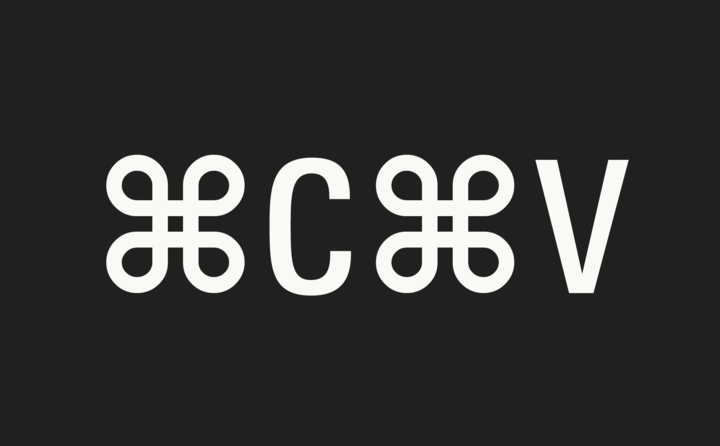Journal
⌘C ⌘V

This academic year Paul has been a first year tutor on the MA Communication Design at Central Saint Martins, a great opportunity to work with engaged students and staff. The MA provides a platform for sharing and developing ideas, the first project he set was called ‘⌘C⌘V’ and centred on his interests in notions of originality, ownership and authorship within the digital age, and yielded some fascinating outcomes. Here is the brief:
THE INTRODUCTION
Throughout history ideas have been shared, riffed, culled, reused, recycled, swiped, stolen, quoted, lifted, duplicated, gifted, appropriated, mimicked, pirated, sampled, remixed, cited, for as long as humans have existed. This is particularly evident within the arts — from the montage and collages of Cubism, Futurism, Constructivism, DADA and Pop, to the Readymades of Marcel Duchamp, to the chance operations of John Cage or William S. Burrough’s cutup technique, to Kayne West’s extensive use of samples.
The Digital Age has introduced two simple keystrokes ⌘C ⌘V that radically undermine and destabilise accepted paradigms of copyright, ownership, authorship and originality. The inherent technological ability to copy data — be it text, image, video, audio etc — has prompted heated debate within the media, institutions, industries and corporations: namely how to manage the continued proliferation of data that would once have been monetised and tightly controlled.
This begs the questions what is original? What is ownership? What is copying? What is authorship? Kenneth Goldsmith, a conceptual poet and founding editor of ubuweb.com (a website archive of the avant–garde) tweeted:
If you don’t want it copied, don’t put it on the web.
— Kenneth Goldsmith @kg_ubu · Sep 3, 2014
How then do we manage and position ourselves, our work and practise within this ever expanding digital and social media landscape? This project asks that you explore processes of reframing / representing / remixing / recontextualising as design and creative strategies.
THE BRIEF
You will respond to two of the following four prompts. Each prompt acts as a starting point for a series of self initiated investigations that will result in an outcome, or series of outcomes. For each prompt you will create new narratives / compositions / readings / images / films / artefacts that have emerged from your ‘sources’.
A ‘source’ could be anything and everything — books, magazines, newspapers, photographs, postcards, found materials, posters, adverts, websites, text messages, emails, Tweets, Facebook updates, YouTube comments, blogs, news websites, films, adverts, music… everything can and must be considered!
THE PROMPTS
01. REMIX: A remix is a piece of media which has been altered from its original state by adding, removing, and/or changing pieces of the item. A song, piece of artwork, book, video, or photograph can all be remixes. The only characteristic of a remix is that it appropriates and changes other materials to create something new.
— Wikipedia definition
02. REWRITE: Rewrite: write (something) again so as to alter or improve it. Synonyms: revise, recast, rework, reword, rephrase, redraft, rescript.
— Google definition
03. REIMAGINE: Reimagine — reinterpret (an event, work of art, etc.) imaginatively; rethink.
— Apple dictionary definition
04. RECONTEXTUALISE: Recontextualise is a process that extracts text, signs or meaning from its original context (decontextualisation) in order to introduce it into another context. Since the meaning of texts and signs depend on their context, recontextualisation implies a change of meaning, and often of the communicative purpose too.
— Wikipedia definition
THE SCHEDULE
Tuesday 20th October: Project briefing / presentation
Tuesday 27th October: ⌘X ⌘C ⌘V — Cut / Copy / Paste Workshop
Tuesday 3rd November: Work in progress tutorials / Feedback
Tuesday 10th November: Exhibition of work / Crit